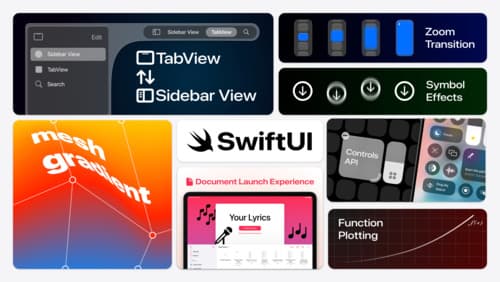List and explain SwiftUI view render optimizations to avoid unnecessary renders
Asked on 2024-09-03
1 search
In the "SwiftUI essentials" session at WWDC 2024, several optimizations for avoiding unnecessary renders in SwiftUI views are discussed:
-
State-Driven Views: SwiftUI views are state-driven, meaning that when the state of a view changes, SwiftUI automatically updates the UI. This eliminates the need for manual updates and reduces the risk of update bugs. SwiftUI maintains a representation of the user interface behind the scenes and uses it to determine how to update its outputs efficiently. This approach helps in avoiding unnecessary renders by only updating the parts of the UI that are affected by state changes.
-
Declarative Structure: SwiftUI views are declarative descriptions of the UI state, not long-lived object instances. This means that views are value types defined using structs, which allows SwiftUI to create an efficient data structure to represent them. This structure is used to produce different outputs, such as what's shown on screen, gestures, and accessibility features. The declarative nature of SwiftUI helps in optimizing rendering by focusing on the current state rather than maintaining a persistent object state.
-
Composition: SwiftUI encourages breaking up views into smaller components. This does not hurt performance because views are just declarative descriptions. Composition allows developers to organize code in a way that is both efficient and easy to manage, without compromising performance.
-
Adaptive Views and Modifiers: Many views and modifiers in SwiftUI have adaptive qualities that take advantage of composition to affect behavior and enable customization. This adaptability helps in optimizing rendering by ensuring that only the necessary parts of the UI are updated.
These optimizations are part of the broader capabilities of SwiftUI to efficiently manage UI updates and rendering, ensuring smooth performance and reducing unnecessary computations.
For more details, you can refer to the SwiftUI essentials session.

What’s new in SwiftUI
Learn how you can use SwiftUI to build great apps for any Apple platform. Explore a fresh new look and feel for tabs and documents on iPadOS. Improve your window management with new windowing APIs, and gain more control over immersive spaces and volumes in your visionOS apps. We’ll also take you through other exciting refinements that help you make expressive charts, customize and layout text, and so much more.

Create custom visual effects with SwiftUI
Discover how to create stunning visual effects in SwiftUI. Learn to build unique scroll effects, rich color treatments, and custom transitions. We’ll also explore advanced graphic effects using Metal shaders and custom text rendering.

Get started with HealthKit in visionOS
Discover how to use HealthKit to create experiences that take full advantage of the spatial canvas. Learn the capabilities of HealthKit on the platform, find out how to bring an existing iPadOS app to visionOS, and explore the special considerations governing HealthKit during a Guest User session. You’ll also learn ways to use SwiftUI, Swift Charts, and Swift concurrency to craft innovative experiences with HealthKit.
